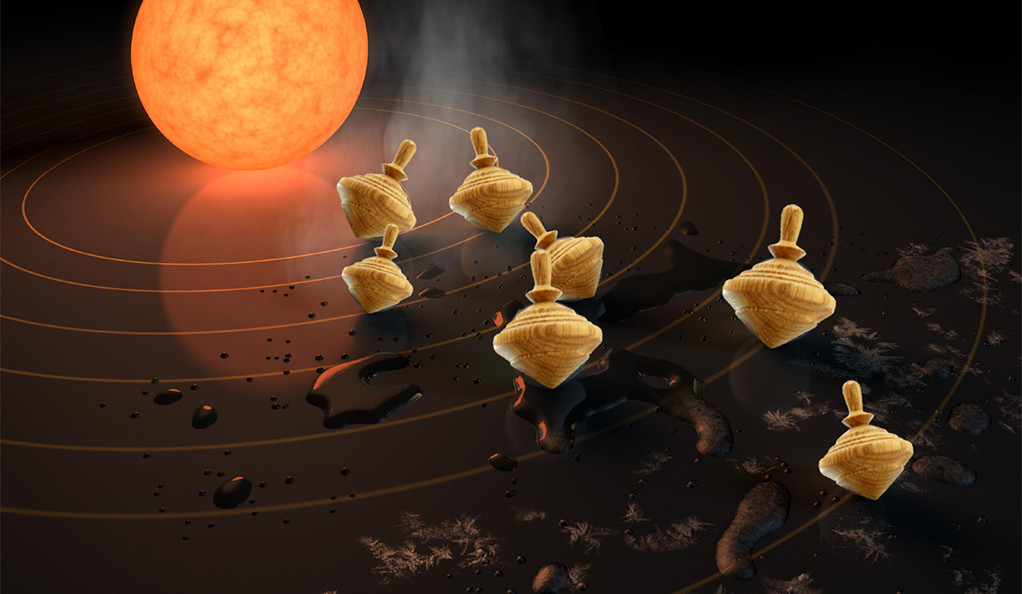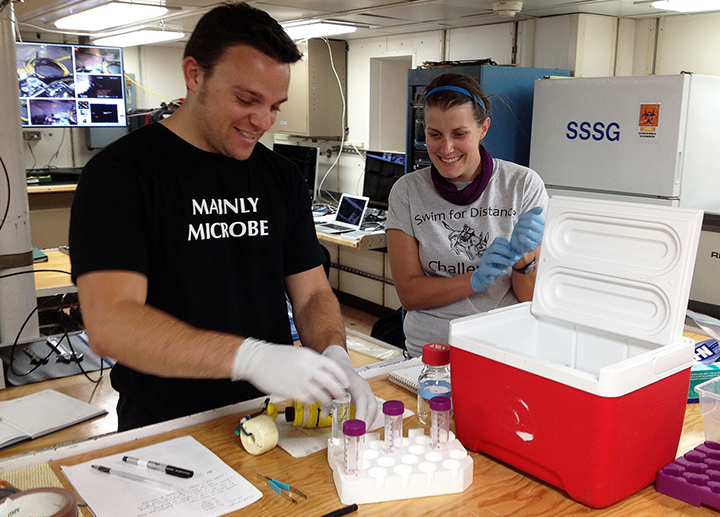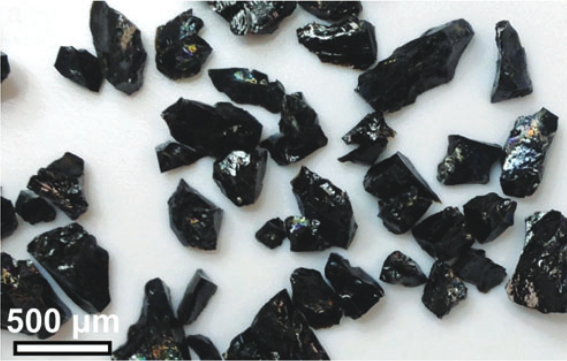Three billion years ago, Earth was a very different place.
-
AbGradCon 2019: Now Accepting Abstracts

Application Deadline EXTENDED: April 1, 2019
AbGradCon 2019 will be hosted by the University of Utah in Salt Lake City from July 22nd – 26th, 2019. This year’s theme will be Science Communication.
The Proposal Writing Retreat (PWR), formerly known as the Research Focus Group (RFG), will take place at from July 19th – 22nd, 2019. Applicants for AbGradCon will be able to apply for PWR at the same time as they submit their AbGradCon application. AbGradCon has funds to support a limited number of participants, although the event can accommodate participants able to provide some or all of their ...
Source: [AbGradCon]
March 14, 2019 • Posted by: Miki Huynh • Report issue
-
NASA Selects Teams to Study Untouched Moon Samples

11 December 1972 -- Scientist-astronaut Harrison H. Schmitt collects lunar rake samples at Station 1 during the first Apollo 17 extravehicular activity (EVA) at the Taurus-Littrow landing site. Schmitt is the lunar module pilot. The Lunar Rake, an Apollo Lunar Geology Hand Tool, is used to collect discrete samples of rocks and rock chips ranging in size from one-half inch (1.3 cm) to one inch (2.5 cm). Credits: Eugene A. Cernan, Apollo 17 CommanderNASA has selected nine teams to continue the science legacy of the Apollo missions by studying pieces of the Moon that have been carefully stored and untouched for nearly 50 years. A total of $8 million has been awarded to the teams.
“By studying these precious lunar samples for the first time, a new generation of scientists will help advance our understanding of our lunar neighbor and prepare for the next era of exploration of the Moon and beyond, “ said Thomas Zurbuchen, Associate Administrator for NASA’s Science Mission Directorate in Washington, DC. “This exploration will bring with it new ...
Source: [NASA]
March 11, 2019 • Written by: NASA • Report issue
-
The Case of the Over-Tilting Exoplanets

Yale researchers have discovered a surprising link between the tilting of exoplanets and their orbit in space. The discovery may help explain a long-standing puzzle about exoplanetary orbital architectures. (Illustration: NASA/JPL-Caltech, Sarah Millholland)For almost a decade, astronomers have tried to explain why so many pairs of planets outside our solar system have an odd configuration — their orbits seem to have been pushed apart by a powerful unknown mechanism. Yale researchers say they’ve found a possible answer, and it implies that the planets’ poles are majorly tilted.
The finding could have a big impact on how researchers estimate the structure, climate, and habitability of exoplanets as they try to identify planets that are similar to Earth. The research appears in the March 4 online edition of the journal Nature Astronomy.
The press release is available through Yale News.
Source: [Yale News]
March 06, 2019 • Written by: Jim Shelton • Report issue
-
Clues to the Early Rise of Oxygen on Earth Found in Sedimentary Rock

Photo of stromatolites in Shark Bay, Western Australia. Scientists have found evidence for ocean oxygenation happening at an earlier date than the Great Oxygenation Event in Mt. McRae Shale in Western Australia. Source: A. Anbar / ASUThe Great Oxidation Event (GOE), an event marking the rise of oxygen in the early Earth’s atmosphere, is estimated to have happened between 2.5 and 2.3 billion years ago. In a study led by researchers at Arizona State University, and supported in part by the NASA Astrobiology Institute, scientists analyzing ancient shale samples found in Western Australia have discovered evidence for significant ocean oxygenation occurring before the GOE, and as far down as the sea floor. This opens up new questions about the GOE and how and why oceanic build-up of O2 happened.
The paper, “Fully oxygenated ...
Source: [Nature Geosciences (via ASU)]
March 05, 2019 • Posted by: Miki Huynh • Report issue
-
NASA Study Reproduces Origins of Life on Ocean Floor

An image of Saturn's moon Enceladus backlit by the Sun, taken by the Cassini mission. The false color tail shows jets of icy particles and water that spray into space from an ocean that lies deep below the moon's icy surface. Future missions could search for the ingredients for life in an ocean on an icy moon like Enceladus.Credit: NASA/JPL/Space Science InstituteScientists have reproduced in the lab how the ingredients for life could have formed deep in the ocean 4 billion years ago. The results of the new study offer clues to how life started on Earth and where else in the cosmos we might find it.
Astrobiologist Laurie Barge and her team at NASA’s Jet Propulsion Laboratory in Pasadena, California, are working to recognize life on other planets by studying the origins of life here on Earth. Their research focuses on how the building blocks of life form in hydrothermal vents on the ocean floor.
The full press release is available at NASA Jet Propulsion Laboratory.
The research, “Redox and pH gradients drive amino acid synthesis in iron oxyhydroxide mineral systems,” is published in the Proceedings of the National Academy of Sciences.
Source: [NASA JPL]
February 26, 2019 • Written by: NASA • Report issue
-
NASA Roadmap to Ocean Worlds
The NASA Outer Planets Assessment Group (OPAG) Roadmaps to Ocean Worlds (ROW) group has published a guide with recommendations on how to develop an initiative for the research of Ocean Worlds. This includes confirmed ocean worlds Enceladus, Titan, and Europa and candidate worlds such as Triton. Development of the roadmap began in 2016.
The overarching goal of an Ocean Worlds exploration program as defined by ROW is to “identify ocean worlds, characterize their oceans, evaluate their habitability, search for life, and ultimately understand any life we find.”
The NASA Roadmap to Ocean Worlds is published in Astrobiology.
Source: [Astrobiology / OPAG]
February 12, 2019 • Posted by: Miki Huynh • Report issue
-
Deep Sea Microbes Hold Clues to Early Life

Study author Stephanie Carr works with a student to process deep-sea samples aboard the R/V Atlantis. A recent study found that a group of unusual microbes living below the seafloor provides clues to the evolution of life on Earth, and potentially other planets. Source: R. Kaplan / Bigelow Laboratory for Ocean SciencesA new study conducted by a team of researchers from Bigelow Laboratory for Ocean Sciences, the University of Hawai‘i at Mānoa, and the Department of Energy Joint Genome Institute, supported in part by the NASA Astrobiology Institute, reveals how a group of deep-sea microbes, Hydrothermarchaeota, could provide clues to the evolution of life on Earth. Instead of cultivating the Hydrothermarchaeota cells in the lab, the researchers were able to use novel genetic sequencing methods (genomics) to learn more about how they evolved strategies to survive life in an extreme environment.
The paper, “Carboxydotrophy potential of uncultivated Hydrothermarchaeota from the ...
Source: [ISME Journal (via Bigelow Laboratory for Ocean Sciences)]
February 12, 2019 • Posted by: Miki Huynh • Report issue
-
Non-Biological Formation of Tubules in Subsurface Volcanic Glass

Image of basalt glass shards before being put through an experiment to test whether microtubules will form after exposure to seawater and whether the glass will be altered by fluid-rock interactions. Source: T. McCollom / C. Donaldson / Astrobiology.A connection between microbial activity and the appearance of microtubules in basalt glass has been proposed in the past, but direct evidence for biological processes being in their formation is still lacking and non-biological origins are possible. Thomas McCollom and Christopher Donaldson, supported in part by the NASA Astrobiology Institute team based at the University of Colorado, have conducted an experiment simulating a process where subsurface glass would be exposed to seawater and altered by fluid-rocks interaction, a process that might also lead to the formation of microtubules. Their results did not produce evidence for non-biological tubule formation, but did ...
Source: [Astrobiology]
February 07, 2019 • Posted by: Miki Huynh • Report issue
-
Scientists Discover DNA "Damage-Up" Proteins
Taking on a new approach to understanding the connections between cellular growth and cancer, a collaborative research group led by researchers at the Baylor College of Medicine have identified proteins in the bacteria E. Coli that, when overproduced, can cause DNA mutation and damage to E. coli cells. These “damage-up” proteins (or DDPs) are a wide and varied network of proteins with a stronger link to cancer than other observed sets of proteins. The researchers have also found 284 DDP relatives among human proteins.
The paper, “Bacteria-to-Human Protein Networks Reveal Origins of Endogenous DNA Damage” is published in Cell ...
Source: [Cell (via UIUC)]
February 05, 2019 • Posted by: Miki Huynh • Report issue
-
AbSciCon 2019

Image source: AbSciCon / Astrobiology at NASAThe Astrobiology Science Conference (AbSciCon) 2019 takes place June 24-28, 2019 in Seattle, WA. Don’t miss your chance to attend!
Abstract Submissions Deadline: March 6, 2019
Registration Deadline: May 30, 2019The theme for AbSciCon 2019 is “Understanding and Enabling the Search for Life on Worlds Near and Far.” Within our solar system, icy worlds and Mars have generated excitement, and exoplanets offer numerous and diverse environments where life may exist in other planetary systems. Near future missions and observations will scrutinize many of these targets to understand their environments and search for signs of life. Meanwhile, fundamental research on ...
Source: [AbSciCon]
February 01, 2019 • Posted by: Miki Huynh • Report issue
-
Astrobiology, Discovery, and Societal Impact Wins 2019 PROSE Award

Second Baruch S. Blumberg/Library of Congress Chair Steven J. Dick's book, Professional and Astrobiology, Discovery, and Societal Impact wins the 2019 Professional Scholarly Excellence Award. Image source: Steven J. Dick / Cambridge University PressThe Association of American Publishers has named Steven J. Dick’s book Astrobiology, Discovery, and Societal Impact (Cambridge University Press, 2018) the PROSE winner for 2019 in the category of Cosmology and Astronomy. The PROSE (Professional and Scholarly Excellence) Awards are considered the Oscars of academic publishing. The book uses history, discovery, and analogy to analyze the possible impacts to humanity of discovering life beyond Earth.
The announcement is available at the Assocation of American Publishers website.
___
Related story: New Book Published on the Societal Impact of Astrobiology
Source: [Association of American Publishers]
January 31, 2019 • Posted by: Miki Huynh • Report issue
-
Extremophiles That Love Water Heaters

Scientists, with the help of citizen scientists, have discovered heat-loving microbes living in water heaters in homes across the United States. Image source: Zhidan Zhang / Penn StateWith the help of citizen scientists, researchers have discovered that hardy microorganisms able to live in hot springs and thermal vents are also thriving in water heaters in various homes across the US. The strain T. scotoductus, a strain that has been discovered in environments such as hot springs and gold mines throughout the world, dominates even in locations near the hot springs of Yellowstone National Park where other thermophiles might be expected to predominate.
The research is published in Extremophile.
Excerpted from the press release from Penn State News:
“Water heaters are unique because they are isolated from each ...
Source: [Extremophile (via Penn State)]
January 28, 2019 • Posted by: Miki Huynh • Report issue
-
Abiotic Formation of the Sugar of DNA

In the Astrophysics and Astrochemistry Lab at NASA's Ames Research Center, researchers Michel Nuevo, Christopher Materese, and Scott Sandford study the cosmic origins of molecules that are important to life. Credits: NASA/Ames Research Center/Dominic HartThe NASA Astrobiology Institute team based at the NASA Ames Research Center have successfully produced 2-Deoxyribose—the sugar component of DNA—from ultraviolet irradiation of water and methanol mixtures under simulated astrophysical conditions. These experiments were conducted in the Astrochemistry Laboratory at Ames and suggest that the compounds to start life could have been delivered via asteroids and comets.
“Deoxyribose and deoxysugar derivatives from photoprocessed astrophysical ice analogues and comparison to meteorites” is published in Nature Communications.
A feature story is published at the NASA Ames Research Center website.
Source: [Nature Communications (via NASA Ames Research Center)]
December 21, 2018 • Written by: NASA • Report issue
-
SAGANet: Ask an Expert

Image source: SAGANetFor those curious about the field of astrobiology and don’t know where to start, the Social Action for a Grassroots Astrobiology Network (SAGANet) has created a new “Ask” page for inquiring minds to send questions directly to an astrobiology expert.
To sign up and submit questions, visit: http://saganet.org/ask
For more information about the organization, including upcoming events and broadcasts, visit the SAGANet.org website.
Source: [SAGANet]
December 14, 2018 • Posted by: Miki Huynh • Report issue
-
Watch the Landing of NASA's Mars InSight

This illustration shows a simulated view of NASA's Interior Exploration using Seismic Investigations, Geodesy and Heat Transport (InSight) lander firing retrorockets to slow down as it descends toward the surface of Mars. Credits: NASA/JPL-CaltechNASA’s Mars Interior Exploration using Seismic Investigations, Geodesy and Heat Transport (InSight) lander is scheduled to touch down on the Red Planet at approximately 3 p.m. EST Nov. 26, and viewers everywhere can watch coverage of the event live on NASA Television, the agency’s website and social media platforms.
Launched on May 5, InSight marks NASA’s first Mars landing since the Curiosity rover in 2012. The landing will kick off a two-year mission in which InSight will become the first spacecraft to study Mars’ deep interior. Its data also will help scientists understand the formation of all rocky worlds, including our own.
Read the press release from NASA.
For more on InSight and its connection to astrobiology, visit the Astrobiology at NASA website.
Source: [NASA]
November 26, 2018 • Written by: NASA • Report issue



